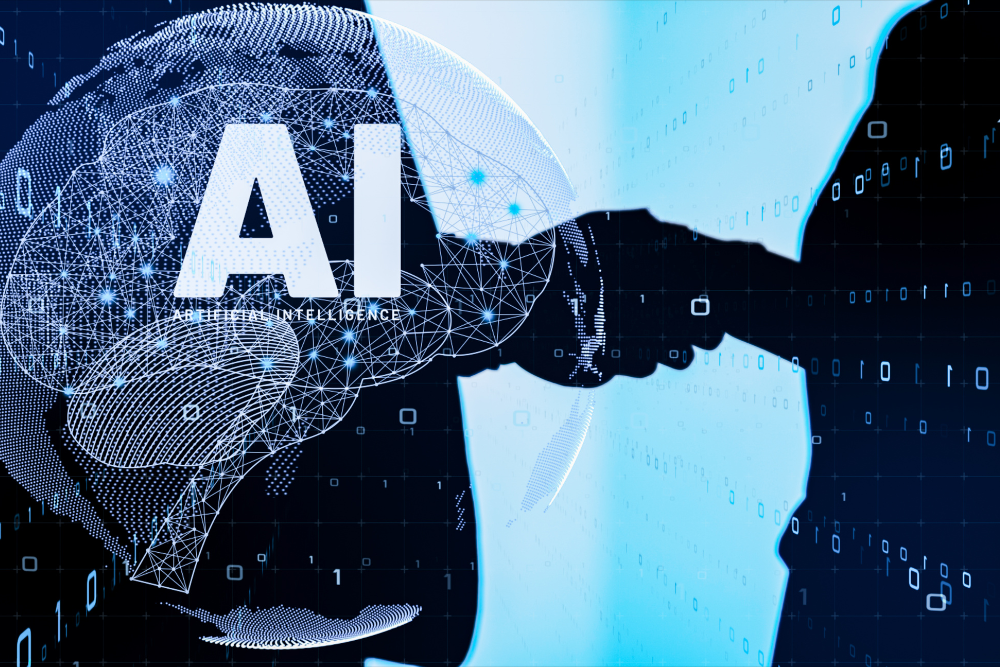Artificial Intelligence 101: Explaining Basic AI Concepts, You Need to Know
Introduction: Navigating the Complex World of Artificial Intelligence
In today’s technology driven economy, artificial intelligence (AI) has emerged as a game-changing force, revolutionizing industries and reshaping the way we interact with technology. From smartphones to smart factories, AI is becoming increasingly ubiquitous in our daily lives and business operations. For small and medium-sized enterprises (SMEs) in the manufacturing sector, understanding the basics of AI is no longer just a competitive advantage—it’s a necessity for survival and growth.
As Jason Vanzin, CISSP and CEO of Right Hand Technology Group, emphasizes, “AI is not just a buzzword; it’s a fundamental shift in how we approach problem-solving and decision-making in business. SMEs that grasp these concepts early will be better positioned to leverage AI for their growth and security.”
In this comprehensive guide, we’ll demystify key AI concepts, exploring their relevance in modern technology and their potential impact on your business. By the end of this article, you’ll have a solid foundation in AI fundamentals, enabling you to make informed decisions about implementing AI for business growth and enhancing your cybersecurity posture.
Why SMEs Can’t Wait on AI Adoption
The AI revolution isn’t just coming—it’s already here. And for small and medium-sized enterprises (SMEs), particularly in sectors like manufacturing, logistics, and professional services, the timing couldn’t be more critical. AI is no longer a futuristic investment for tech giants—it’s a practical tool for solving real-world problems right now.
1. Labor Shortages and Efficiency Pressures
Across industries, SMEs are struggling to find and retain skilled labor. AI offers a way to fill the gaps—not by replacing workers, but by enhancing productivity and reducing manual workload. Whether it’s automating repetitive admin tasks or enabling predictive maintenance in manufacturing, AI allows your existing team to do more with less.
“With the right AI tools, a five-person team can now operate at the efficiency of a ten-person operation—without burning out your people,” says Jason Vanzin, CISSP and CEO of Right Hand Technology Group.
2. Cybersecurity Threats Are Growing
The cybersecurity landscape is escalating rapidly, and SMEs are increasingly in the crosshairs. AI-powered cyber threats (like automated phishing or deepfake impersonation) require AI-powered defenses. The longer you wait to adopt AI in your security strategy, the more vulnerable your business becomes.
AI is already being used in tools like endpoint detection and response (EDR), automated threat hunting, and email filtering—but many businesses haven’t activated these capabilities yet.
3. Competitors Are Already Investing
AI adoption isn’t just for enterprise-level firms anymore. Low-code and prebuilt AI tools have made it accessible and cost-effective—even for businesses without in-house data science teams. If your competitors are using AI to improve customer service, optimize workflows, or reduce errors, you risk falling behind.
4. Government Policies and Incentives
Governments and industry groups are beginning to encourage (and in some cases, mandate) more intelligent, automated systems—especially in regulated industries. Getting a head start on AI adoption can position your business for easier compliance and access to funding programs tied to modernization and innovation.
1. Understanding Artificial Intelligence (AI) Definition
1.1 Definition of AI and Its Significance
Artificial Intelligence refers to the development of computer systems capable of performing tasks that typically require human intelligence. These tasks include visual perception, speech recognition, decision-making, and language translation. The significance of AI lies in its ability to process vast amounts of data, identify patterns, and make predictions or decisions with speed and accuracy that often surpass human capabilities.
AI’s importance in problem-solving and decision-making tasks cannot be overstated. It enables businesses to:
- Automate routine processes
- Gain insights from complex data sets
- Enhance customer experiences
- Optimize operations and resource allocation
The applications of AI span various industries, from finance and healthcare to manufacturing and retail. For instance, AI in healthcare is transforming patient care through improved diagnostics, personalized treatment plans, and drug discovery.
“In the manufacturing sector,” Vanzin notes, “AI is driving predictive maintenance, quality control, and supply chain optimization. SMEs that adopt AI-driven solutions can significantly enhance their operational efficiency and competitiveness.”
AI Myths That Hold Businesses Back
Despite the buzz around artificial intelligence, many small and mid-sized business leaders still hesitate to explore it. That hesitation often stems from outdated assumptions or media-fueled misconceptions. Let’s set the record straight on a few of the most common myths.
Myth #1: “AI is only for big companies with massive budgets.”
Reality: Not anymore. The rise of cloud-based platforms and AI-as-a-Service tools has made AI accessible—even for businesses without dedicated IT departments. From AI-powered chatbots to intelligent document processing, many solutions are affordable, fast to deploy, and require minimal technical overhead.
Tools like Microsoft Copilot, Google Cloud AI, and custom solutions from managed service providers (MSPs) now offer enterprise-grade capabilities for SME budgets.
Myth #2: “AI will replace my team.”
Reality: AI isn’t here to take jobs—it’s here to eliminate tedious, time-consuming tasks. In most SME environments, AI acts as a productivity partner, helping staff focus on higher-value work. Think of it as hiring a tireless assistant, not a replacement.
Examples:
- AI flags errors so staff don’t have to manually review every record.
- AI chatbots handle FAQs, so your support team can focus on real issues.
- AI in cybersecurity monitors threats 24/7, so your team doesn’t have to.
Myth #3: “I need tons of data to get started.”
Reality: While large datasets power complex AI models, many off-the-shelf AI tools work well with small data—or even without historical data. Pre-trained models, like GPT-4 or image classifiers, can be fine-tuned or customized for your needs without a massive database.
Start small. A pilot project using your existing customer service transcripts or operations logs is often enough to generate early wins.
Myth #4: “AI is just another word for automation.”
Reality: Automation is one application of AI—but AI goes much further. AI can learn from data, make predictions, and adapt over time. It’s the difference between a rule-based script and a system that continuously improves.
Examples of AI beyond automation:
- Predicting when a machine will fail based on usage data (predictive maintenance)
- Grouping customers into behavioral segments automatically (unsupervised learning)
- Interpreting handwritten forms and converting them into digital text (computer vision + NLP)
2. Delving into Machine Learning
Machine Learning (ML) is a subset of AI that focuses on the development of algorithms and statistical models that enable computer systems to improve their performance on a specific task through experience.
2.1 Exploring Supervised Learning
Supervised learning is a type of ML where the algorithm is trained on a labeled dataset. The model learns to map input data to the correct output based on example input-output pairs.
Key points about supervised learning:
- Requires labeled data for training
- Ideal for classification and regression tasks
- Widely used in image recognition and spam detection
2.2 Unpacking Unsupervised Learning
Unsupervised learning algorithms work with unlabeled data, attempting to find patterns or structures within the dataset without predetermined categories.
Characteristics of unsupervised learning:
- Works with unlabeled data
- Useful for discovering hidden patterns or groupings
- Applications include customer segmentation and anomaly detection
2.3 Diving into Reinforcement Learning
Reinforcement learning is an area of ML where an agent learns to make decisions by interacting with an environment. The agent receives rewards or penalties based on its actions, allowing it to learn optimal behavior over time.
Key aspects of reinforcement learning:
- Learning through trial and error
- Balancing exploration of new actions with exploitation of known successful actions
- Used in robotics, game playing, and autonomous systems
3. Unraveling Deep Learning
Deep Learning is a subset of machine learning that uses artificial neural networks with multiple layers to progressively extract higher-level features from raw input.
3.1 Introduction to Neural Networks
Neural networks are computing systems inspired by the biological neural networks in animal brains. They consist of interconnected nodes (neurons) organized in layers.
Key components of neural networks:
- Input layer: Receives initial data
- Hidden layers: Process and transform data
- Output layer: Produces the final result
- Weights and biases: Adjusted during training to improve performance
3.2 Harnessing the Power of Deep Learning
Deep learning leverages neural networks with many layers (deep neural networks) to learn complex patterns in data.
Advantages of deep learning:
- Automatic feature extraction from raw data
- Ability to handle large and complex datasets
- State-of-the-art performance in tasks like image and speech recognition
4. Applying AI Concepts in Real-world Scenarios
4.1 AI Models for Tailored Solutions
AI models are the backbone of intelligent systems, designed to process data and make predictions or decisions. Foundation models, like GPT-4 and Claude 3, are versatile AI systems trained on vast amounts of data that can be fine-tuned for specific tasks.
“For SMEs in manufacturing,” Vanzin explains, “AI models can be tailored to optimize production processes, predict equipment failures, and even enhance quality control. The key is to start with a solid foundation and customize it to your specific needs.”
4.2 Enhancing Human-Computer Interaction with Natural Language Processing
Natural Language Processing (NLP) is a branch of AI that focuses on the interaction between computers and humans using natural language. NLP enables machines to understand, interpret, and generate human language in a valuable way.
Applications of NLP include:
- Chatbots and virtual assistants
- Sentiment analysis
- Language translation
- Text summarization
4.3 Exploring the Creativity of Generative AI
Generative AI refers to AI systems capable of creating new content, such as images, text, or music. These systems learn patterns from existing data and use that knowledge to generate original outputs.
Key techniques in generative AI:
- Generative Adversarial Networks (GANs)
- Variational Autoencoders (VAEs)
- Transformer-based language models
Getting Started: How SMEs Can Begin Using AI Today
Understanding AI is one thing—implementing it is another. The good news? You don’t need to be a data scientist or invest in a multi-million dollar project to start seeing results. For SMEs, the smartest AI strategies begin with small, focused steps that solve real business problems.
Step 1: Identify a High-Impact Use Case
Start by looking for pain points in your daily operations—areas where your team is spending too much time, making frequent errors, or struggling to keep up.
Common entry points for SMEs:
- Customer Service: AI chatbots can handle repetitive inquiries and free up human agents.
- Operations: Use AI to track inventory levels, forecast demand, or detect anomalies.
- Finance/Admin: AI tools can automate invoice matching, expense approvals, or fraud detection.
- Cybersecurity: Leverage AI-powered tools to detect threats, analyze logs, and flag risks faster than human teams can.
“The best place to start is where you feel the most friction,” advises Jason Vanzin. “That’s where AI can create immediate value.”
You don’t need to build a custom model from scratch. Instead, look for AI capabilities built into tools you may already use (like Microsoft 365, QuickBooks, or your CRM). Or explore entry-level platforms with AI baked in:
- Grammarly Business (for writing enhancement)
- Zapier + AI actions (for smart automations)
- Tidio or Drift (for AI chatbots)
- Darktrace or SentinelOne (for AI-based security)
Managed service providers can also help evaluate, deploy, and maintain the right stack for your needs.
Step 3: Pilot, Measure, Improve
Start with a narrow pilot. Define a clear goal—like reducing customer response time by 30%, or cutting downtime by 20%—and track your results. This builds internal confidence and gives you the data to justify further investment.
Tips for a successful AI pilot:
- Set a timeline (30–90 days)
- Assign ownership (who’s testing, who’s measuring)
- Document what works and what doesn’t
- Iterate before expanding
Step 4: Build Toward a Broader AI Roadmap
Once you’ve proven success in one area, begin identifying additional use cases and scaling gradually. Think in terms of AI maturity:
- Task-level automation
- AI-assisted decision making
- Full integration into business strategy
Remember, AI is not a one-and-done initiative—it’s a long-term capability that grows with your business.
Coming up next: we’ll explore how AI is transforming human-computer interaction through Natural Language Processing (NLP), and what that means for your customer experience and internal workflows.
How AI Strengthens Your Cybersecurity Posture
Cybersecurity isn’t just an IT issue anymore—it’s a business survival issue. As cyber threats evolve in speed and sophistication, traditional defenses are no longer enough. That’s where AI comes in. By augmenting human analysts with intelligent systems, AI provides a faster, smarter way to detect, respond to, and even prevent cyberattacks.
Real-Time Threat Detection
AI-powered cybersecurity tools excel at processing huge volumes of data in real time. Unlike rule-based systems, AI can:
- Detect subtle anomalies in network traffic
- Spot suspicious user behavior
- Flag potential insider threats or credential misuse
This allows businesses to catch threats before they escalate into full-blown breaches.
“SMEs often lack large security teams,” says Jason Vanzin. “AI acts as a force multiplier—running 24/7, watching everything, and learning what ‘normal’ looks like.”
Faster, Smarter Incident Response
In the event of a cyber incident, AI can:
- Correlate alerts across systems to reduce noise
- Prioritize critical threats over false positives
- Recommend or even automate response actions (e.g., isolating an endpoint)
This accelerates response time and reduces reliance on overwhelmed IT staff or manual triage processes.
Phishing and Email Security
AI is now essential in fighting phishing attacks—especially the new wave of AI-generated emails and deepfake-style impersonation.
AI can:
- Analyze email content, sender patterns, and historical context
- Identify spoofed domains or suspicious links
- Flag anomalies invisible to standard spam filters
And with AI-enhanced email gateways or secure email platforms, SMEs can defend against increasingly deceptive attacks before users even see them.
Risk-Based Access and Identity Protection
AI is also playing a major role in identity and access management (IAM). By analyzing behavioral patterns, AI systems can:
- Flag unusual login attempts
- Enforce adaptive multi-factor authentication (MFA)
- Automatically revoke access when suspicious behavior is detected
This creates a more proactive, context-aware security posture—something every business needs in an increasingly remote and hybrid work environment.
With AI in your cybersecurity toolkit, you’re no longer relying on reactive defense. You’re building a system that can learn, adapt, and respond faster than human attackers. For SMEs operating without large security teams, this shift can be the difference between staying protected or suffering a costly breach.
Frequently Asked Questions About AI for SMEs
Q: Do I need a technical background to implement AI in my business?
A: Not at all. Many AI-powered tools today are designed for business users with no coding experience. You can start with off-the-shelf platforms or work with a trusted IT partner or MSP who handles the technical side for you.
Q: What’s the difference between AI, machine learning, and automation?
A: Automation follows fixed rules. Machine learning is a type of AI that learns patterns from data. AI includes both—plus capabilities like natural language processing, image recognition, and content generation.
Q: Isn’t AI too expensive for small businesses?
A: AI has become much more affordable. Many tools operate on a pay-as-you-go or SaaS model. Plus, the time and cost savings from automation often outweigh the upfront investment.
Q: How long does it take to see results from AI?
A: You can start seeing impact within weeks—especially if you begin with a focused use case like customer support automation or predictive maintenance. Larger initiatives may take longer, but pilots should deliver quick wins.
Q: Is AI safe to use in cybersecurity and compliance-heavy environments?
A: Yes—but like any tech, it depends on how it’s implemented. Many cybersecurity tools use AI to enhance threat detection and access control. Choose solutions from trusted vendors and work with experts who understand your compliance landscape (e.g., HIPAA, CMMC, NIST).
Q: What’s the first step I should take if I want to explore AI?
A: Identify one business challenge where AI could save time, reduce risk, or improve accuracy. Then explore tools or talk to a service provider with AI experience. Start small, test, measure, and build from there.
Conclusion: Embracing the Future of Artificial Intelligence
As we’ve explored in this comprehensive guide, artificial intelligence encompasses a wide range of concepts and technologies that are reshaping the business landscape. From machine learning algorithms that power predictive analytics to deep learning systems that enable advanced image recognition, AI offers unprecedented opportunities for innovation and growth.
For SME manufacturers and businesses, understanding these AI fundamentals is crucial for staying competitive in an increasingly tech-driven market. As Jason Vanzin aptly puts it, “AI in cybersecurity and SMB cybersecurity solutions are no longer optional—they’re essential components of a robust business strategy in the digital age.”
We encourage you to continue exploring AI concepts and their potential applications in your industry. Consider how implementing AI for business growth could transform your operations, enhance your products, and improve your customer experiences.
Remember, the future belongs to those who prepare for it today. By embracing AI and its transformative potential, you’re positioning your business at the forefront of innovation and growth.
Ready to take the next step in your AI journey? Download our eBook “Harnessing AI for Small Business Growth” to discover practical AI applications for your business. Don’t miss out on this valuable resource—click here to get your copy now!











